Contents
Scarlet Sage
Scarlet Sage (Salvia coccinea) is a vibrant herbaceous perennial in the mint family known for its brilliant red flowers and long blooming season. Often grown as a tender annual in cooler climates, this eye-catching sage adds bold color and a touch of wild beauty to gardens. Its spires of tubular blooms are a magnet for hummingbirds and butterflies, providing abundant nectar throughout the warm months. The plant forms a bushy, upright clump of aromatic green foliage that sets off the fiery blossoms. Gardeners value Scarlet Sage for its ease of care and resilience – it tolerates heat and humidity well, and with regular deadheading it will produce waves of fresh blooms from summer until frost. Whether used in borders, cottage gardens, or pollinator patches, Scarlet Sage delivers season-long interest and stands out among other summer bloomers with its intense scarlet display and wildlife appeal.
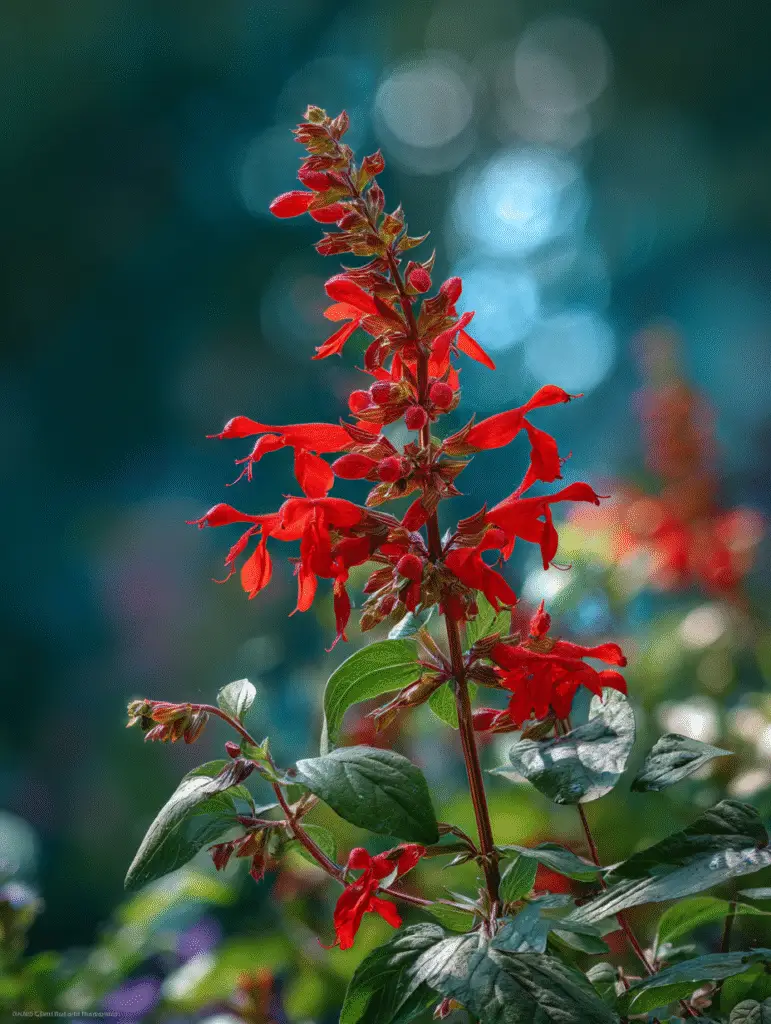
🌱 Taxonomy and origin
Scarlet Sage belongs to the genus Salvia, which encompasses around 900 species of sages in the mint family (Lamiaceae). The botanical name Salvia coccinea reflects its defining color, as “coccinea” is Latin for scarlet. In the garden world, the name “Scarlet Sage” usually refers to this species, though another ornamental sage from Brazil (Salvia splendens) is also commonly called scarlet sage – a different plant with similar red flowers. Salvia coccinea is native to the southeastern United States, Mexico, and parts of Central and South America, where it thrives in warm, subtropical climates. It is in fact the only sage native to the U.S. that bears red blooms.
As a member of a diverse genus, Scarlet Sage has relatives with blossoms in nearly every hue – blue, purple, pink, white, and yellow flowers can all be found on various salvias. However, Salvia coccinea is most renowned for its intense red coloration. In its native range it grows wild in sunny clearings and along roadsides. Today, Scarlet Sage is cultivated worldwide as an ornamental, valued for bringing a touch of the tropics to temperate gardens and for its adaptability to different settings. Plant breeders have even developed cultivars of Scarlet Sage with colors beyond red, including soft pink flowers, pure white flowers, and warm salmon-orange flowers, broadening the palette while retaining the species’ easygoing nature and charm.
🌸 Bloom time
Scarlet Sage is a prolific bloomer that lights up the garden from early summer all the way until the first autumn frost. Once the weather heats up, this plant begins producing its signature scarlet blossoms and hardly pauses. Multiple tiers of tubular flowers open sequentially on each spike, ensuring a continuous show for weeks on end. In warm regions with mild winters, it can even bloom nearly year-round. By contrast, in colder zones it starts flowering in summer and keeps going until cold weather finally stops it. Gardeners will find that Scarlet Sage’s peak performance comes during the height of summer – it loves heat and will often bloom even when many other plants struggle. Regular deadheading (removing the spent flowers) helps redirect the plant’s energy into new buds, yielding an even longer bloom period. While spring bulbs like tulips have long faded by mid-summer, Scarlet Sage is hitting its stride, providing consistent color when many early-season flowers are gone. This extended bloom time makes it invaluable for keeping gardens vibrant well into fall. The bright red or occasionally pink/white blooms not only please the eye for months on end, they also continuously draw in hummingbirds and butterflies throughout the season, making the garden a lively scene of activity.
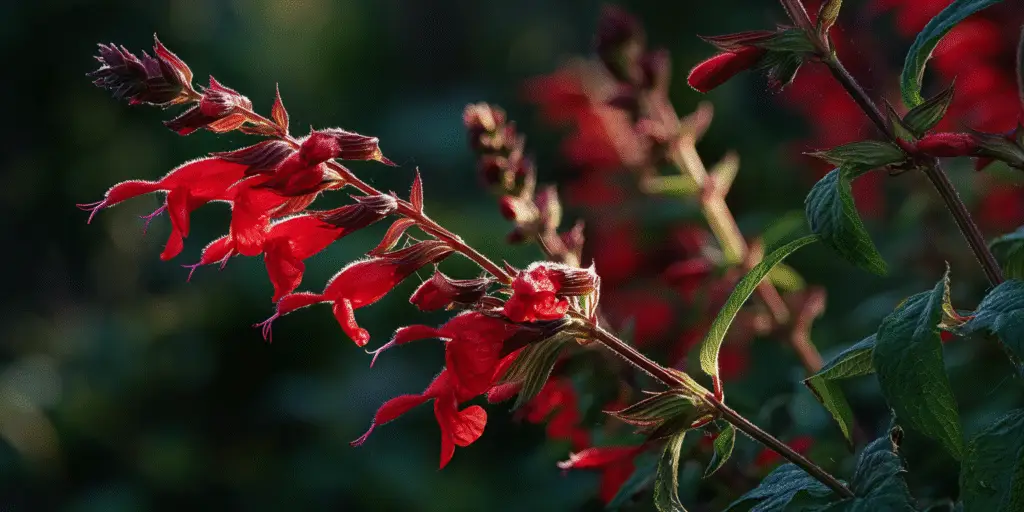
📏 Height and spread
In growth habit, Scarlet Sage forms an upright, bushy subshrub that typically reaches about 2 to 3 feet in height and roughly 1 to 2 feet in spread under cultivation. In ideal conditions it may grow towards the taller end of that range (up to 4 feet high), especially in warm climates or rich soil, while some compact varieties stay shorter. The plant tends to branch readily from the base, creating a somewhat vase-shaped form with multiple flower spikes held above the foliage. Each stem is square (a mint family trait) and supports opposite pairs of medium-green leaves with softly serrated edges. The overall impression is a full, airy mound of foliage punctuated by bright blooms. Scarlet Sage is substantial enough to hold its own mid-border, yet not so giant as to overwhelm smaller neighbors. For scale, it will stand taller than low edging plants but remains much shorter than towering giants like sunflower or large shrubs, making it a versatile middle-layer plant in mixed plantings. It also works nicely in containers, where it can bush out and spill into an attractive mound of color. Given room, a single plant can eventually reach a couple feet across; spacing individuals about 12-18 inches apart is recommended to allow for good air circulation and full shape. Overall, its height and spread are moderate, fitting well into many garden designs without dominating the space.
☀️ Light
Like most salvias, Scarlet Sage thrives in bright conditions. Full sun (at least 6 hours of direct sunlight per day) is ideal for maximum flowering and sturdy growth. In abundant sun, the plant produces more blooms and stays compact. It will tolerate partial shade – especially in the heat of afternoon – but too much shade can lead to lanky growth and reduced flowering. In climates with very intense summer sun, a bit of afternoon shade can actually help prevent delicate flower colors (such as the pale pink or white varieties) from scorching. However, as a general rule, more light equals more flowers for Scarlet Sage. Gardeners should plant it in an open spot that receives good sunshine; a south-facing or west-facing exposure works well.
One of the advantages of Scarlet Sage is its ability to flourish where many other flowering plants might struggle with too much sun. For example, while a shade-loving shrub like azaleas prefers dappled light and would wilt in all-day sun, Scarlet Sage relishes it. In lower light situations, the plant will survive but may not put on the prolific bloom show it is capable of. If growing indoors or in a greenhouse (where it can flower even in winter under warmth and light), providing strong supplemental light will be important. In summary, plant Scarlet Sage in the sunniest part of your garden for best results – the reward will be a robust display of blooms basking in the sunshine.
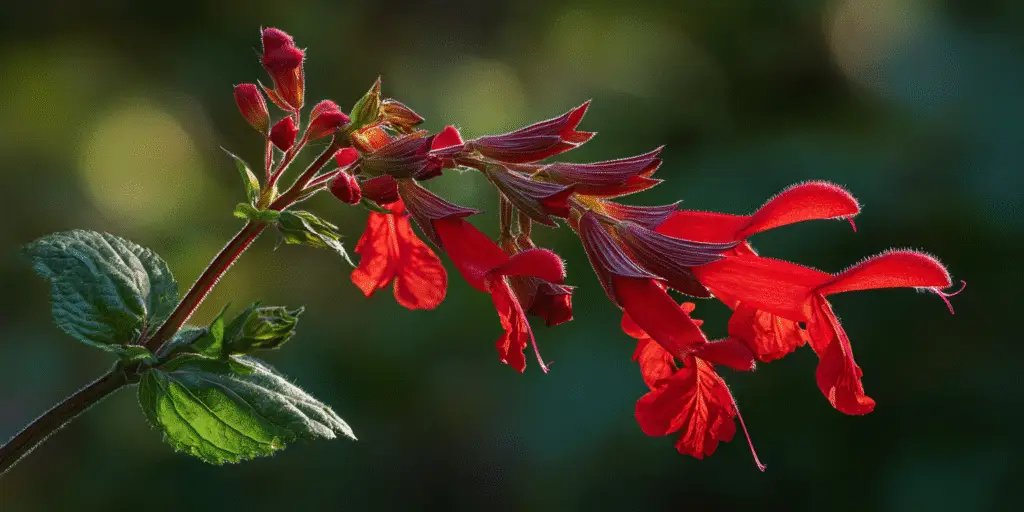
💧 Water
Scarlet Sage has moderate water needs and appreciates consistent moisture, but it is not overly fussy about water once established. It grows best in soil that is kept evenly moist but never waterlogged. Good drainage is important because like many sages, it does not like having “wet feet.” In practice, this means watering thoroughly when the top inch of soil feels dry, then allowing excess to drain away. During periods of regular rainfall, Scarlet Sage usually fares well without much intervention, but during extended dry spells, providing a deep watering will keep it blooming happily. The plant can tolerate short droughts – its slightly thick, hairy leaves help conserve water – but prolonged drought stress may cause fewer flowers and drooping foliage. Mulching around the base can help retain soil moisture in hot weather. Compare its water preference to thirstier garden plants like hydrangea macrophylla, which require constant moisture to keep from wilting; Scarlet Sage is more forgiving. It strikes a balance: not as desert-dry hardy as some succulents, but certainly more drought-tolerant than water-loving flowering shrubs. In containers, you will need to water more frequently since pots dry out faster (possibly daily in summer heat). Always water at the base rather than overhead to avoid wetting the leaves, as consistently wet foliage can encourage mildew. By meeting Scarlet Sage’s moderate water needs – moistening the soil when needed but avoiding saturation – gardeners will be rewarded with vigorous plants that bloom continuously.
🌍 Soil and pH
Adaptability is one of Scarlet Sage’s strong suits when it comes to soil. This plant isn’t very demanding about soil type as long as two key conditions are met: decent drainage and a reasonable level of fertility. In the wild it often grows in sandy or rocky soils, so it is well adapted to soils that are on the lean or coarse side. In the garden, Scarlet Sage will do well in average loam or even in clay that has been loosened with organic matter, provided excess water can drain. Highly fertile soil can promote lots of leafy growth at the expense of flowers, so extremely rich soil or heavy over-fertilization is not necessary.
Regarding soil pH, Scarlet Sage is quite tolerant – it can grow in slightly acidic to slightly alkaline soils (roughly pH 5.5 to 7.5) without issue. Unlike a plant such as hydrangea macrophylla, which famously changes bloom color based on soil pH and prefers strongly acid soil, Scarlet Sage doesn’t require special pH adjustments. Whether your garden soil is mildly acidic or leans toward alkaline, this sage should adapt as long as nutrients are present. If given a choice, a neutral to mildly acidic pH (around 6.0 to 7.0) is often optimal for nutrient availability, but again, Scarlet Sage is not particularly finicky. To sum up its soil needs: a well-drained garden bed enriched with a bit of compost will make Scarlet Sage happy. Avoid boggy, poorly drained locations (where it may rot) and extremely dry nutrient-poor sand (where it may struggle), but anything in between – from sandy loam to clay loam – can work. This flexibility in soil and pH preferences makes it easy to place Scarlet Sage in various garden settings without much amendment.
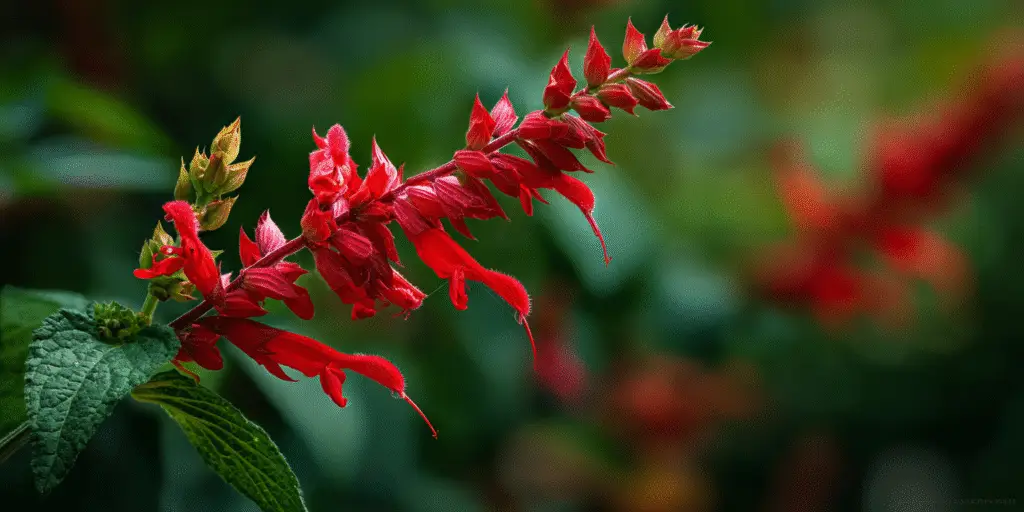
❄️ USDA hardiness
Scarlet Sage is botanically a perennial, but its hardiness is limited to warmer regions. In USDA hardiness zones 9 and 10 (and warmer), it can survive year to year outdoors, since winter temperatures in those zones generally stay above freezing or only occasionally dip to light frost. In these warm climates, Scarlet Sage may behave as a short-lived perennial subshrub that can get slightly woody at the base and resprout for several seasons. Gardeners in frost-free tropical areas might even see it bloom continuously. However, in any region that experiences significant frost or snow (zones 8 and colder), Scarlet Sage is usually grown as an annual. It will perish with the first hard freeze of winter. In zones 6-8, it often manages to drop seeds before dying, and those seeds can sprout the next spring, making the plant “come back” in a sense via its offspring. This self-seeding habit sometimes allows Scarlet Sage to naturalize or reappear annually even where it isn’t winter-hardy. Still, you should treat it as an annual in those climates, replanting each year or relying on volunteer seedlings.
To enjoy it as a perennial, gardeners in marginal areas might overwinter plants indoors or in a greenhouse. Essentially, Scarlet Sage’s hardiness is akin to other heat-loving annual flowers like zinnias or cosmos – it loves the summer but cannot withstand a true winter. If you live north of zone 9, plan to either collect seeds and re-sow next spring or let the plant reseed itself, because the same individual plant will not survive deep cold. Knowing your zone and frost dates is key: wait until after the last frost to plant Scarlet Sage outdoors, and expect it to grow and flower robustly through the summer and early fall, but not to overwinter outside in cold regions.
🌼 Propagation and longevity
Propagating Scarlet Sage is straightforward, with seeds being the most common method. This plant produces plenty of small, dark seeds in the spent flower calyces as blooms fade. Gardeners can collect these seeds in fall or simply allow them to drop to the soil, where many will sprout the following growing season (especially in warmer climates). If starting from seed on purpose, sow them shallowly in seed-starting mix – they need light to germinate, so do not bury them deep. It’s best to start seeds indoors 6-8 weeks before your last frost date to get a jump on the season. With warmth (around 70°F) and moisture, seeds typically germinate in about 2 to 3 weeks. The seedlings grow quickly and can be transplanted outside once the weather is reliably warm. Another propagation option is taking softwood cuttings from a favorite plant during the growing season; these can root in a moist potting medium, though growing from cuttings is usually done to preserve specific cultivars since seeds may not come true to type for hybrids. Scarlet Sage can also be divided if you have an established clump – in zones where it survives year-round, a larger plant can sometimes be dug up and split in spring.
In terms of longevity, individual Scarlet Sage plants are not especially long-lived perennials. In frost-free gardens they might persist for a few years before becoming woody or less vigorous. Many gardeners treat them as a two- or three-year plant even in warm zones, refreshing plantings periodically with new seedlings or cuttings. In colder zones of course, they function as annuals, completing their life cycle in one growing season. Fortunately, because Scarlet Sage reseeds readily and grows so fast, it’s easy to have a continuous presence of this plant in the garden year after year – last year’s plants may be gone after winter, but new ones often pop up, carrying on the display with minimal effort from the gardener.
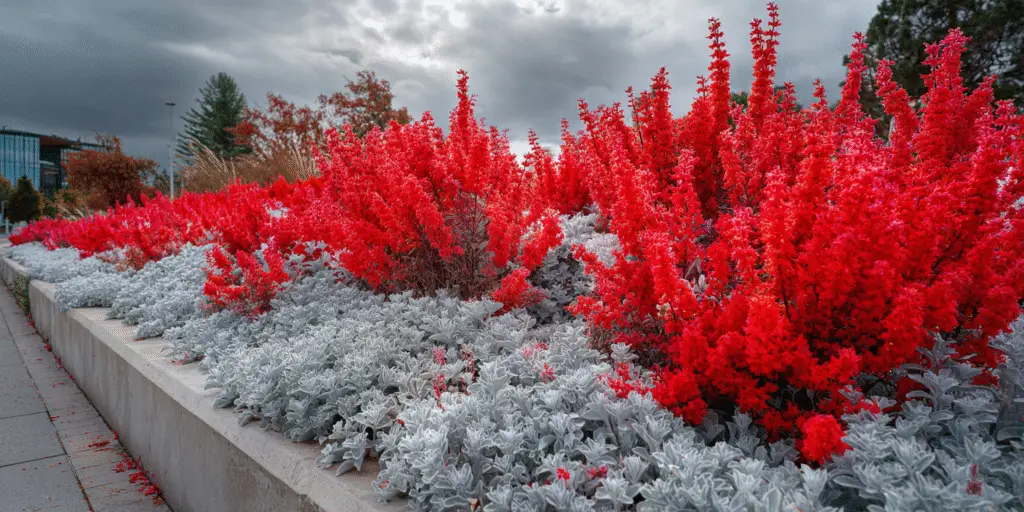
👃 Fragrance
Despite being in the aromatic mint family, Scarlet Sage is not particularly known for having a strong fragrance. Its appeal lies more in visual impact than in scent. The flowers themselves have little to no noticeable fragrance to human noses – you won’t catch a perfumed cloud from these blooms as you might from roses or jasmine. The foliage, if brushed or crushed, can emit a mild herbal scent reminiscent of sage or mint, but it is fairly subtle and not a prominent feature of the plant in the garden. This contrasts with some other garden favorites like roses or phlox, which are often grown specifically for their sweet-smelling blossoms. Scarlet Sage, on the other hand, is grown for the vivid color and for attracting pollinators rather than for perfuming the air. In a mixed planting, its neutral fragrance profile means it won’t clash with or overpower the scents of other nearby flowers. Some gardeners do report a light pleasant smell from the leaves on hot days or when watering, but generally you would have to get quite close and handle the plant to detect it. If adding Scarlet Sage to a sensory or fragrant garden, consider pairing it with more aromatic companions to add scent, while Scarlet Sage contributes bold color. Overall, fragrance is one area where Scarlet Sage is modest – it won’t provide much olfactory delight, but its bright presence and nectar-rich flowers more than make up for the lack of perfume.
⚠️ Toxicity and pet safety
Gardeners with pets and children can breathe a sigh of relief when it comes to Scarlet Sage – this plant is considered non-toxic. Unlike certain popular landscape plants such as azaleas or oleanders (which contain substances poisonous if ingested), Scarlet Sage does not have known toxic compounds that pose a danger to people or common domestic animals. According to the ASPCA, Salvia coccinea is not toxic to dogs, cats, or horses. In practical terms, if a curious pet were to nibble on a leaf or a child were to handle the plant, it should not cause poisoning concerns. Of course, ingestion of any non-food plant material in large quantities could lead to mild digestive upset, so it’s still wise to discourage pets from grazing on ornamentals as a general rule. But you won’t find Scarlet Sage on lists of hazardous plants. In fact, members of the sage family are sometimes used as culinary herbs (though this particular species isn’t a common edible sage, it shares the family’s overall safety). One thing to note: because Scarlet Sage can reseed and spread in warm climates, if you have livestock or grazing animals, they might encounter it in a pasture – even so, it’s not known to cause harm. The bottom line is that Scarlet Sage is a pet-friendly choice for gardens, bringing color without the worry. It’s always a good idea to monitor any new plant around curious pets, but this bright red sage should coexist nicely with your cats and dogs. Having a non-toxic bloomer in the yard means you can enjoy the show without concern for your furry friends.
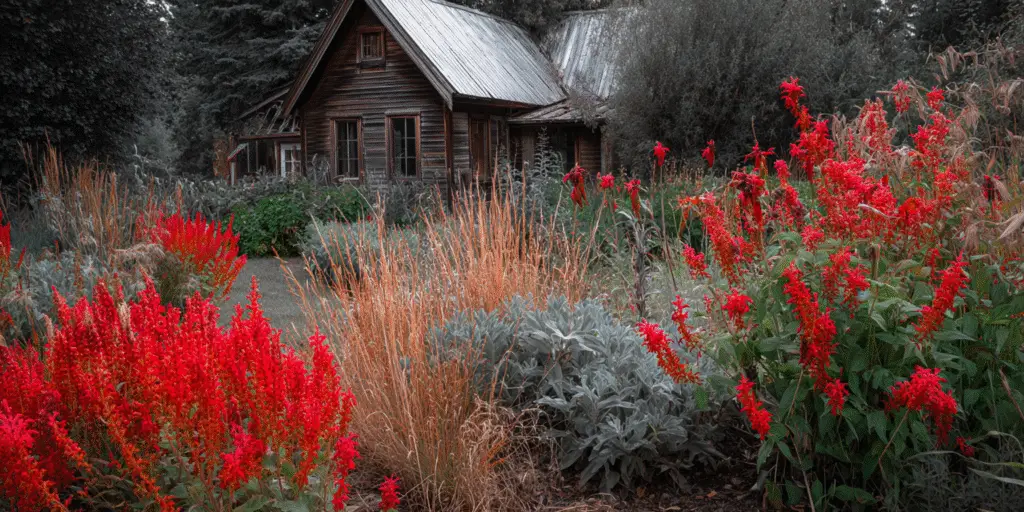
🌿 Vase life
In addition to shining in the landscape, Scarlet Sage can also be cut for informal floral arrangements, where it lends a wildflower charm. When used as a cut flower, its vase life is moderate. The slender, nectar-filled blooms of Scarlet Sage will typically last several days in water – often around 4 to 7 days of good appearance, depending on conditions. They may not have the prolonged vase longevity of some classic cut flowers, but they make up for it with a delicate, airy presence and vivid color. To maximize vase life, it’s best to cut Scarlet Sage stems in the morning when they are well hydrated. Select stems where about one-third to one-half of the flowers on the spike are open, while others are still in bud – this way, additional blooms will continue to open in the vase as the earlier ones fade. Immediately place the cut stems in clean, lukewarm water. Strip off any leaves that would sit below the water line to prevent rot. Using floral preservative can help extend freshness, but even simply changing the water every couple of days will make a difference. Expect that the lowest blossoms on each spike might wilt first; you can pinch those off to keep the arrangement looking tidy.
The stems of Scarlet Sage are relatively thin, so they pair well in mixed bouquets with sturdier focal flowers. Their red blooms add pops of color and draw the eye. Some gardeners like to combine Scarlet Sage in arrangements with other summer cutting-garden staples – for instance, the red spires look lovely alongside zinnias or cosmos. In a mixed bouquet, Scarlet Sage’s flowers hold up reasonably well for nearly a week. By day five or so, you might notice they start declining. As long as you’re okay with a shorter-lived bouquet (versus long-lasting chrysanthemums or carnations, for example), Scarlet Sage is a delightful addition to cut flower arrangements, bringing a bit of your orange flowers-filled summer garden indoors.
🐛 Pests and diseases
Scarlet Sage is generally a robust plant with few serious pest or disease issues, which is part of its appeal for low-maintenance gardening. In many cases, it can be grown without needing any pesticides or major interventions. One notable advantage is that Scarlet Sage is not a preferred snack for deer – the foliage’s slightly pungent, resinous qualities mean deer and rabbits tend to leave it alone, especially when other tastier options are available. This makes it a valuable plant in areas where deer pressure is high and beloved plants like tulips or hostas often get nibbled. In terms of insect pests, outdoor plantings of Scarlet Sage rarely suffer significant damage. On occasion, you might find common garden pests such as aphids or whiteflies on the stems, but these usually don’t reach infestation levels and can be managed by spraying the plant with water or a gentle insecticidal soap if needed. In greenhouse or indoor environments, pests like mealybugs or spider mites could appear, particularly if air circulation is poor. Regular monitoring and good airflow help prevent those issues.
The most noteworthy disease that can affect Scarlet Sage is powdery mildew, a fungal disease that shows up as a white powdery coating on leaves. Scarlet Sage’s foliage is somewhat susceptible to mildew, especially later in the season or in crowded, shady, or damp conditions. To minimize powdery mildew, provide adequate spacing between plants for air circulation, and try to water the soil rather than splashing the leaves. If mildew does appear, removing the worst affected leaves and improving air flow can keep it in check; it rarely kills the plant, mostly just spoils its looks. Other fungal issues like root rot can occur only if the soil stays waterlogged for too long – which reinforces the importance of good drainage. Overall, gardeners will find Scarlet Sage to be relatively trouble-free. It doesn’t tend to suffer from the beetles or caterpillars that plague some other flowers, and even the mildew can often be avoided with a bit of care. In a mixed planting, Scarlet Sage can actually help reduce pest problems by attracting predatory insects and by not being a focal point for pests itself. With minimal attention to placement and hygiene, this sage will grow and bloom vigorously without much in the way of pest or disease setbacks.
FAQs
Is Scarlet Sage an annual or a perennial?
Scarlet Sage can be either, depending on your climate. Botanically it’s a perennial subshrub, but it is only winter-hardy in warm regions (roughly USDA zones 9-10 and above). In colder areas, frost will kill it, so it’s grown as an annual. Many gardeners treat it as an annual everywhere outside the deep South – planting new ones each spring or relying on it to reseed – whereas in frost-free climates the same plant can survive and bloom for multiple years.
How do I propagate Scarlet Sage?
The easiest way to propagate Scarlet Sage is from seed. You can collect seeds from the dried flower spikes at the end of the season. Sow the seeds indoors a couple of months before your last frost (press them lightly into the surface of the soil, as they need light to germinate) or direct-sow after frost has passed. They usually sprout within 2-3 weeks with warmth. Alternatively, you can propagate by stem cuttings in spring or summer – cut a 3-4 inch piece of new growth, remove the lower leaves, and place it in a moist rooting medium until it forms roots. Division of established clumps is another option if the plant has survived winter in mild zones. However, most people find that letting the plant self-seed or starting new seeds each year is the most convenient propagation method.
Does Scarlet Sage attract hummingbirds and butterflies?
Yes, absolutely – Scarlet Sage is famous for attracting hummingbirds, as well as butterflies and other pollinators. The bright red tubular flowers are a beacon for hummingbirds in particular, since they are drawn to red and can easily sip the nectar from the elongated blooms. You’ll often see hummingbirds zipping from flower to flower on a Scarlet Sage plant. Butterflies like swallowtails and fritillaries, and various bees, will also visit the flowers for nectar. If you want to create a pollinator-friendly garden or a hummingbird haven, Scarlet Sage is an excellent choice. It’s often recommended to plant it in groups or masses for a bigger visual signal to passing hummingbirds. Even the occasional moth or beneficial predatory insects will stop by. In short, you can expect Scarlet Sage to be a hub of pollinator activity when it’s in bloom.
Is Scarlet Sage poisonous to pets?
No, Scarlet Sage (Salvia coccinea) is not considered poisonous to common household pets. It is listed as non-toxic to dogs and cats (and even to larger animals like horses). This means if your cat or dog takes a bite out of a Scarlet Sage plant, they should not suffer serious ill effects – unlike if they chewed on something truly toxic like lilies or azaleas. Of course, any plant material might cause minor stomach upset if eaten in large amounts, but Scarlet Sage doesn’t contain the dangerous compounds that some ornamental plants do. Many gardeners specifically choose sage varieties for gardens frequented by pets and children because of this safety factor. So you can plant and enjoy Scarlet Sage without worrying about your pets. Just keep in mind standard pet etiquette in the garden: curious nibblers might still cause damage to the plant itself even if it doesn’t harm the pet!
What colors do Scarlet Sage flowers come in?
The classic Scarlet Sage has bright red flowers – that’s the signature color that gives the plant its name. However, through breeding, there are now several cultivars available that expand the color range. You can find varieties that bloom in pure white (often sold as ‘Snow Nymph’ or similar names), various shades of pink and coral (like the popular ‘Coral Nymph’ which has white and salmon-pink bicolored blossoms, or ‘Summer Jewel Pink’ which is a soft pink), and even some that are a fiery orange-red. There are also lavender or near-purple selections in the broader salvia family (for example, some people include Salvia splendens cultivars which have purple tones under “scarlet sage” in garden contexts). But if we’re speaking about Salvia coccinea specifically, the range is typically red, pink, white, and salmon/peach tones. Garden centers may carry mixes or series (such as the “Summer Jewel” series) where you can choose your color. Keep in mind that if you let these different colors cross-pollinate and self-seed, the next generation might revert to more red-dominant hues. Still, having multiple colors of Scarlet Sage can add a fun variety to your flower bed while maintaining that same easy-care habit of the species.
Can Scarlet Sage grow in shade or indoors?
Scarlet Sage prefers plenty of sun and will bloom best with full sun exposure. It can handle partial shade (for example, morning sun and afternoon shade), but in deep shade it becomes leggy and produces far fewer flowers. A very shaded spot under dense trees is not suitable for a good flower display. Indoors, Scarlet Sage is not ideal as a long-term houseplant because it needs a lot of light and good airflow to thrive. You can start seeds indoors or overwinter a potted Scarlet Sage by keeping it in the brightest possible location (a sunny window or under grow lights), but without strong light it will likely drop leaves and stop blooming. Overall, Scarlet Sage will always perform best outdoors with abundant sunlight; it won’t be as happy or floriferous in full shade or typical indoor conditions.
Interesting tips
- To keep Scarlet Sage blooming its best, pinch off (deadhead) the dried flower spikes regularly. This encourages the plant to channel energy into producing new buds instead of seeds, resulting in a fuller flush of flowers all season long.
- Plant Scarlet Sage in groups rather than as single scattered specimens. Massing several plants together creates a more impactful display and is more likely to catch the attention of hummingbirds. A large grouping of red blooms can be stunning and will stand out against green foliage or alongside contrasting blue flowers and yellow flowers in the garden bed.
- Scarlet Sage can readily reseed itself. If you want volunteers next year, allow a few flower stalks to remain and set seed towards the end of the season. Come spring, you might find new seedlings popping up nearby. These can be transplanted to desired spots or left to grow in place for an effortless continuation of your Scarlet Sage patch.
- Because it has an upright, airy form, Scarlet Sage pairs well with bushier or lower-growing plants at its feet. Consider edging a Scarlet Sage display with colorful annuals like marigolds or petunias, or foliage plants like silver dusty miller, to cover the base and provide a nice color contrast. Its red also complements sun-loving orange flowers and stands out dramatically next to deep violet blooms or nearly black flowers if you have any in your design.
- Although generally problem-free, if your Scarlet Sage does develop powdery mildew (a white powder on leaves), don’t despair. Try trimming off the affected foliage to let new growth emerge, and ensure better air circulation around the plant. A little preventative spacing goes a long way – remember that this sage can grow into a bushy shape, so give each plant enough elbow room to breathe.
- A neat fact for plant enthusiasts: Scarlet Sage’s Latin name coccinea literally means “scarlet-colored,” and it certainly lives up to it. Interestingly, this species is the only native American sage with red blooms, making it a unique native wildflower in the U.S. With such a special place in the plant world, it’s no wonder gardeners across the country enjoy cultivating the beautiful Scarlet Sage.